Role of IT in Research: An Interim Research Proposal ITECH 5500
VerifiedAdded on 2022/10/04
|6
|994
|499
Report
AI Summary
This report provides an interim research proposal on the role of IT in research, specifically focusing on the impact of Artificial Intelligence (AI) and Business Intelligence (BI) on business functions. It highlights the importance of data analytics in decision-making and problem-solving within organizations. The report includes a literature review synthesis matrix, analyzing five articles that discuss the use of ERP systems, big data, and BI for managing various business operations and improving performance. The synthesis matrix examines how these technologies contribute to data analytics, decision-making processes, and overall business growth. The report concludes with a comprehensive list of references.
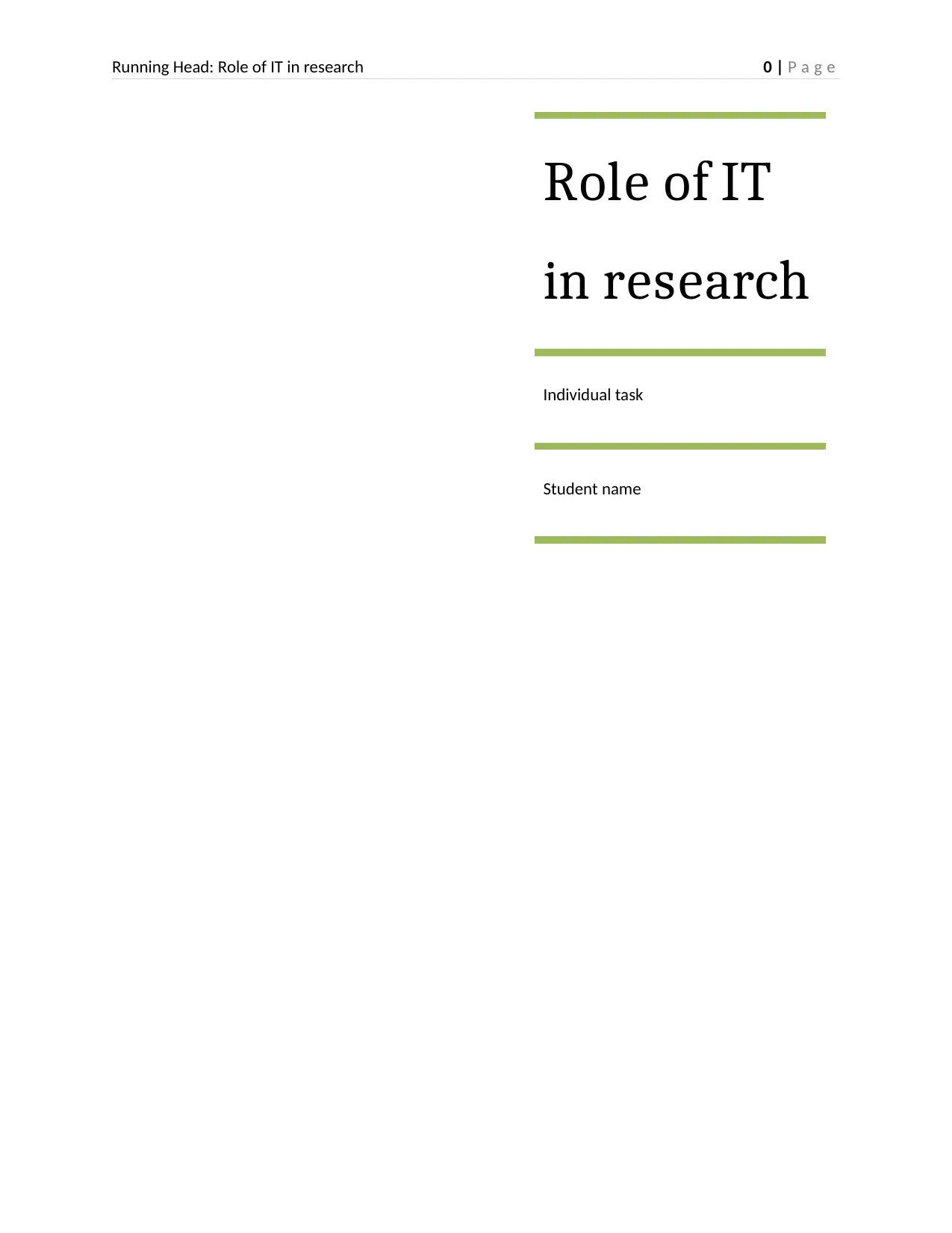
Running Head: Role of IT in research 0 | P a g e
Role of IT
in research
Individual task
Student name
Role of IT
in research
Individual task
Student name
Paraphrase This Document
Need a fresh take? Get an instant paraphrase of this document with our AI Paraphraser
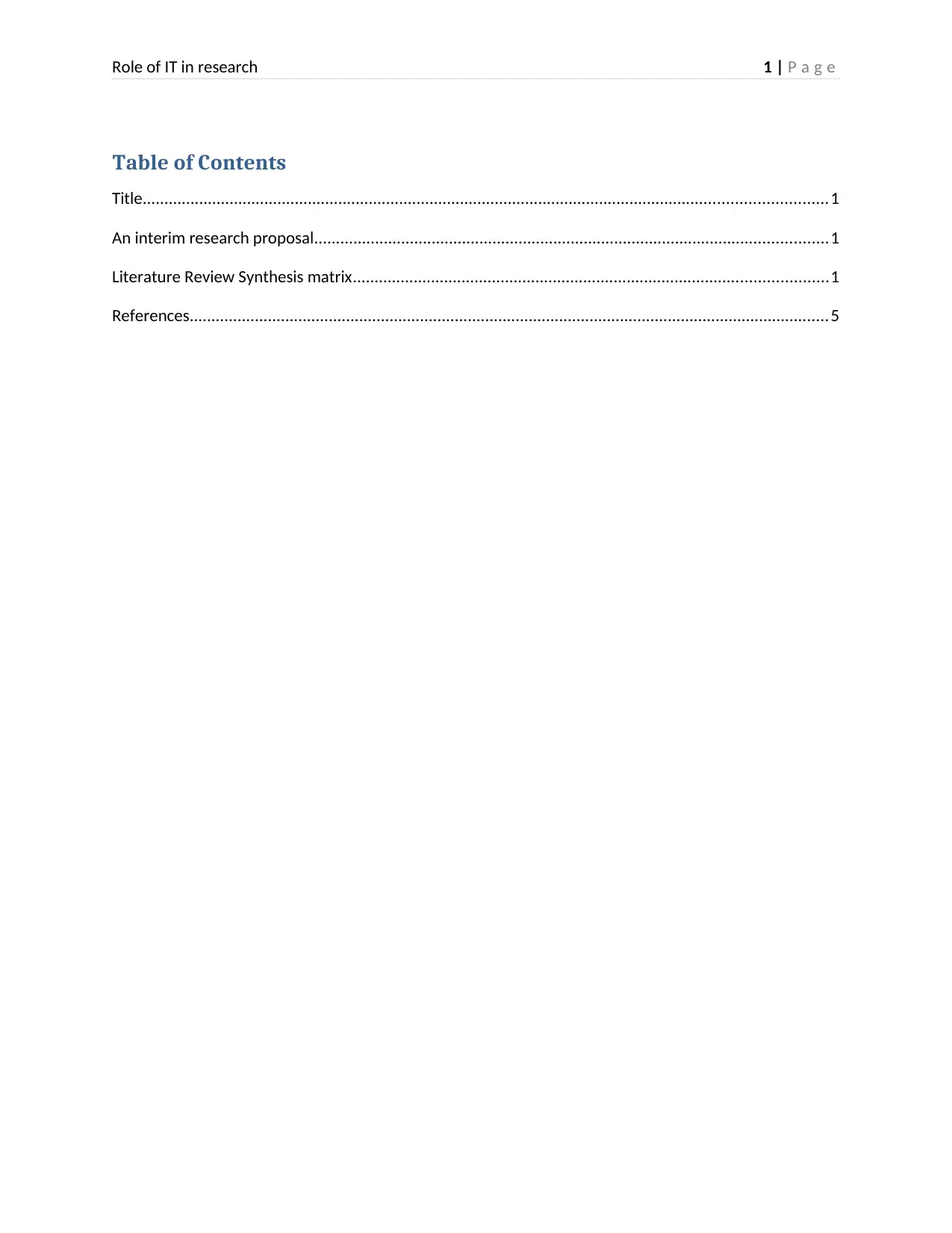
Role of IT in research 1 | P a g e
Table of Contents
Title.............................................................................................................................................................1
An interim research proposal......................................................................................................................1
Literature Review Synthesis matrix.............................................................................................................1
References...................................................................................................................................................5
Table of Contents
Title.............................................................................................................................................................1
An interim research proposal......................................................................................................................1
Literature Review Synthesis matrix.............................................................................................................1
References...................................................................................................................................................5
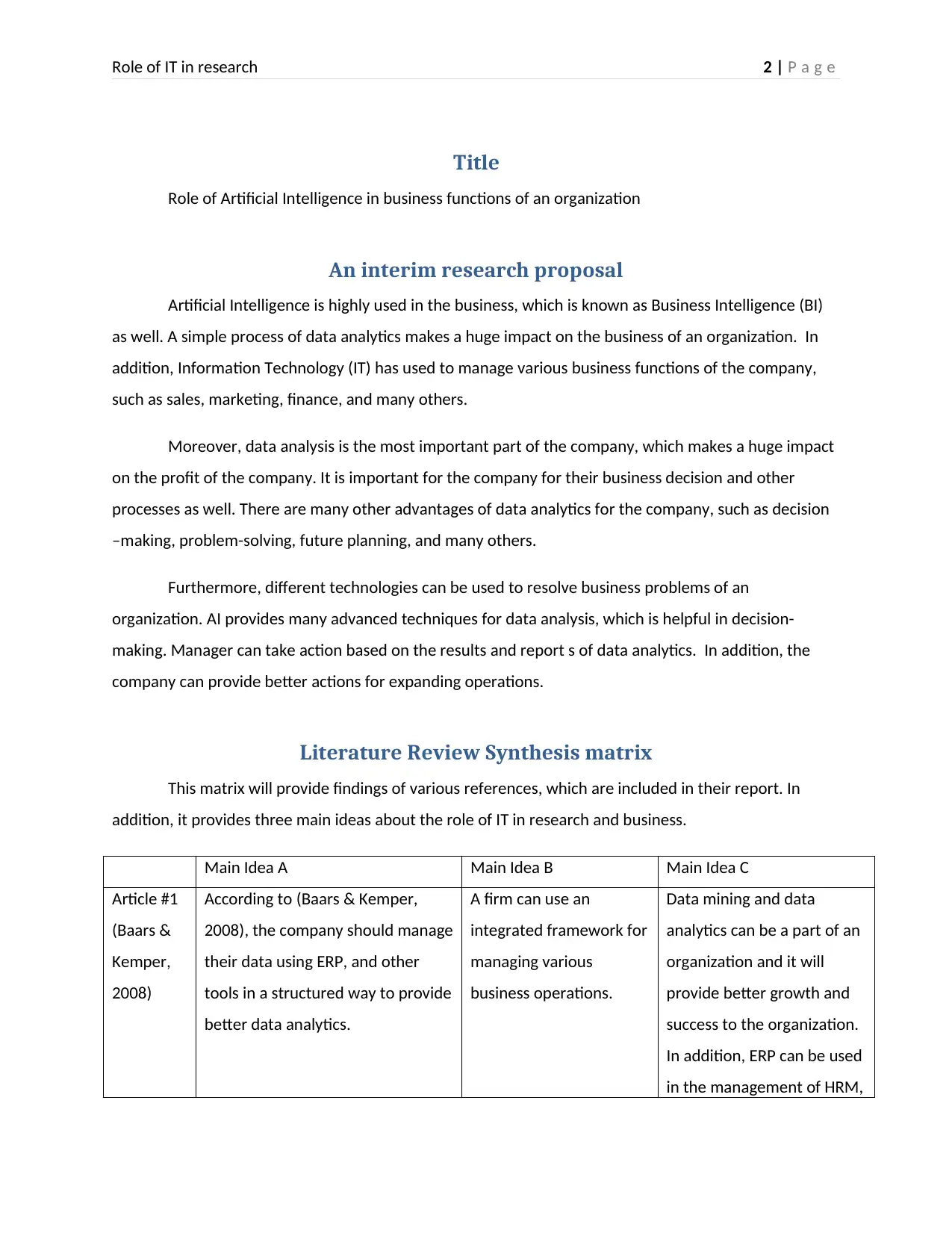
Role of IT in research 2 | P a g e
Title
Role of Artificial Intelligence in business functions of an organization
An interim research proposal
Artificial Intelligence is highly used in the business, which is known as Business Intelligence (BI)
as well. A simple process of data analytics makes a huge impact on the business of an organization. In
addition, Information Technology (IT) has used to manage various business functions of the company,
such as sales, marketing, finance, and many others.
Moreover, data analysis is the most important part of the company, which makes a huge impact
on the profit of the company. It is important for the company for their business decision and other
processes as well. There are many other advantages of data analytics for the company, such as decision
–making, problem-solving, future planning, and many others.
Furthermore, different technologies can be used to resolve business problems of an
organization. AI provides many advanced techniques for data analysis, which is helpful in decision-
making. Manager can take action based on the results and report s of data analytics. In addition, the
company can provide better actions for expanding operations.
Literature Review Synthesis matrix
This matrix will provide findings of various references, which are included in their report. In
addition, it provides three main ideas about the role of IT in research and business.
Main Idea A Main Idea B Main Idea C
Article #1
(Baars &
Kemper,
2008)
According to (Baars & Kemper,
2008), the company should manage
their data using ERP, and other
tools in a structured way to provide
better data analytics.
A firm can use an
integrated framework for
managing various
business operations.
Data mining and data
analytics can be a part of an
organization and it will
provide better growth and
success to the organization.
In addition, ERP can be used
in the management of HRM,
Title
Role of Artificial Intelligence in business functions of an organization
An interim research proposal
Artificial Intelligence is highly used in the business, which is known as Business Intelligence (BI)
as well. A simple process of data analytics makes a huge impact on the business of an organization. In
addition, Information Technology (IT) has used to manage various business functions of the company,
such as sales, marketing, finance, and many others.
Moreover, data analysis is the most important part of the company, which makes a huge impact
on the profit of the company. It is important for the company for their business decision and other
processes as well. There are many other advantages of data analytics for the company, such as decision
–making, problem-solving, future planning, and many others.
Furthermore, different technologies can be used to resolve business problems of an
organization. AI provides many advanced techniques for data analysis, which is helpful in decision-
making. Manager can take action based on the results and report s of data analytics. In addition, the
company can provide better actions for expanding operations.
Literature Review Synthesis matrix
This matrix will provide findings of various references, which are included in their report. In
addition, it provides three main ideas about the role of IT in research and business.
Main Idea A Main Idea B Main Idea C
Article #1
(Baars &
Kemper,
2008)
According to (Baars & Kemper,
2008), the company should manage
their data using ERP, and other
tools in a structured way to provide
better data analytics.
A firm can use an
integrated framework for
managing various
business operations.
Data mining and data
analytics can be a part of an
organization and it will
provide better growth and
success to the organization.
In addition, ERP can be used
in the management of HRM,
⊘ This is a preview!⊘
Do you want full access?
Subscribe today to unlock all pages.

Trusted by 1+ million students worldwide
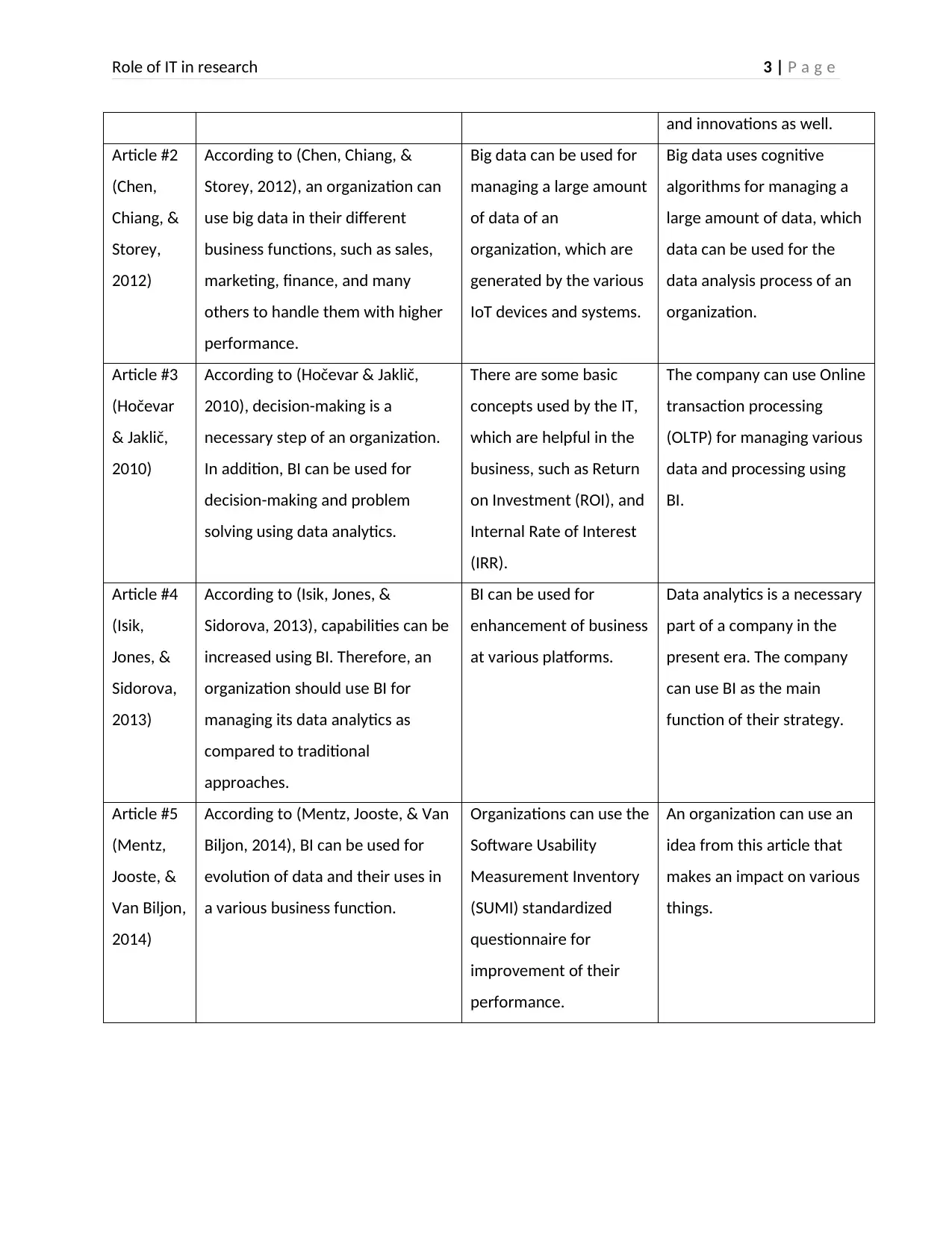
Role of IT in research 3 | P a g e
and innovations as well.
Article #2
(Chen,
Chiang, &
Storey,
2012)
According to (Chen, Chiang, &
Storey, 2012), an organization can
use big data in their different
business functions, such as sales,
marketing, finance, and many
others to handle them with higher
performance.
Big data can be used for
managing a large amount
of data of an
organization, which are
generated by the various
IoT devices and systems.
Big data uses cognitive
algorithms for managing a
large amount of data, which
data can be used for the
data analysis process of an
organization.
Article #3
(Hočevar
& Jaklič,
2010)
According to (Hočevar & Jaklič,
2010), decision-making is a
necessary step of an organization.
In addition, BI can be used for
decision-making and problem
solving using data analytics.
There are some basic
concepts used by the IT,
which are helpful in the
business, such as Return
on Investment (ROI), and
Internal Rate of Interest
(IRR).
The company can use Online
transaction processing
(OLTP) for managing various
data and processing using
BI.
Article #4
(Isik,
Jones, &
Sidorova,
2013)
According to (Isik, Jones, &
Sidorova, 2013), capabilities can be
increased using BI. Therefore, an
organization should use BI for
managing its data analytics as
compared to traditional
approaches.
BI can be used for
enhancement of business
at various platforms.
Data analytics is a necessary
part of a company in the
present era. The company
can use BI as the main
function of their strategy.
Article #5
(Mentz,
Jooste, &
Van Biljon,
2014)
According to (Mentz, Jooste, & Van
Biljon, 2014), BI can be used for
evolution of data and their uses in
a various business function.
Organizations can use the
Software Usability
Measurement Inventory
(SUMI) standardized
questionnaire for
improvement of their
performance.
An organization can use an
idea from this article that
makes an impact on various
things.
and innovations as well.
Article #2
(Chen,
Chiang, &
Storey,
2012)
According to (Chen, Chiang, &
Storey, 2012), an organization can
use big data in their different
business functions, such as sales,
marketing, finance, and many
others to handle them with higher
performance.
Big data can be used for
managing a large amount
of data of an
organization, which are
generated by the various
IoT devices and systems.
Big data uses cognitive
algorithms for managing a
large amount of data, which
data can be used for the
data analysis process of an
organization.
Article #3
(Hočevar
& Jaklič,
2010)
According to (Hočevar & Jaklič,
2010), decision-making is a
necessary step of an organization.
In addition, BI can be used for
decision-making and problem
solving using data analytics.
There are some basic
concepts used by the IT,
which are helpful in the
business, such as Return
on Investment (ROI), and
Internal Rate of Interest
(IRR).
The company can use Online
transaction processing
(OLTP) for managing various
data and processing using
BI.
Article #4
(Isik,
Jones, &
Sidorova,
2013)
According to (Isik, Jones, &
Sidorova, 2013), capabilities can be
increased using BI. Therefore, an
organization should use BI for
managing its data analytics as
compared to traditional
approaches.
BI can be used for
enhancement of business
at various platforms.
Data analytics is a necessary
part of a company in the
present era. The company
can use BI as the main
function of their strategy.
Article #5
(Mentz,
Jooste, &
Van Biljon,
2014)
According to (Mentz, Jooste, & Van
Biljon, 2014), BI can be used for
evolution of data and their uses in
a various business function.
Organizations can use the
Software Usability
Measurement Inventory
(SUMI) standardized
questionnaire for
improvement of their
performance.
An organization can use an
idea from this article that
makes an impact on various
things.
Paraphrase This Document
Need a fresh take? Get an instant paraphrase of this document with our AI Paraphraser

Role of IT in research 4 | P a g e
It is concluded that IT can be used for many business functions. It will provide help in growth and
success of an organization.
It is concluded that IT can be used for many business functions. It will provide help in growth and
success of an organization.
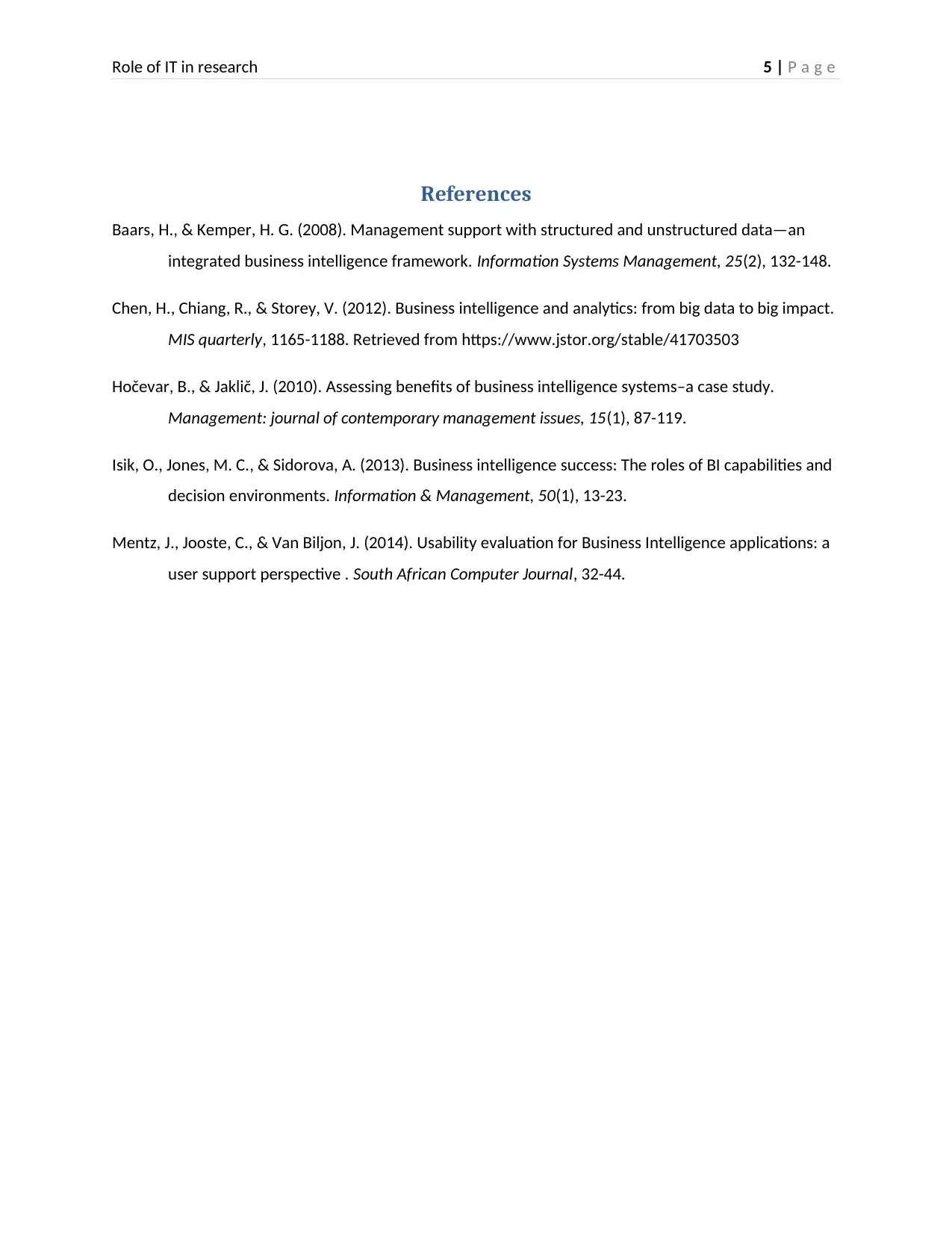
Role of IT in research 5 | P a g e
References
Baars, H., & Kemper, H. G. (2008). Management support with structured and unstructured data—an
integrated business intelligence framework. Information Systems Management, 25(2), 132-148.
Chen, H., Chiang, R., & Storey, V. (2012). Business intelligence and analytics: from big data to big impact.
MIS quarterly, 1165-1188. Retrieved from https://www.jstor.org/stable/41703503
Hočevar, B., & Jaklič, J. (2010). Assessing benefits of business intelligence systems–a case study.
Management: journal of contemporary management issues, 15(1), 87-119.
Isik, O., Jones, M. C., & Sidorova, A. (2013). Business intelligence success: The roles of BI capabilities and
decision environments. Information & Management, 50(1), 13-23.
Mentz, J., Jooste, C., & Van Biljon, J. (2014). Usability evaluation for Business Intelligence applications: a
user support perspective . South African Computer Journal, 32-44.
References
Baars, H., & Kemper, H. G. (2008). Management support with structured and unstructured data—an
integrated business intelligence framework. Information Systems Management, 25(2), 132-148.
Chen, H., Chiang, R., & Storey, V. (2012). Business intelligence and analytics: from big data to big impact.
MIS quarterly, 1165-1188. Retrieved from https://www.jstor.org/stable/41703503
Hočevar, B., & Jaklič, J. (2010). Assessing benefits of business intelligence systems–a case study.
Management: journal of contemporary management issues, 15(1), 87-119.
Isik, O., Jones, M. C., & Sidorova, A. (2013). Business intelligence success: The roles of BI capabilities and
decision environments. Information & Management, 50(1), 13-23.
Mentz, J., Jooste, C., & Van Biljon, J. (2014). Usability evaluation for Business Intelligence applications: a
user support perspective . South African Computer Journal, 32-44.
⊘ This is a preview!⊘
Do you want full access?
Subscribe today to unlock all pages.

Trusted by 1+ million students worldwide
1 out of 6
Related Documents
Your All-in-One AI-Powered Toolkit for Academic Success.
+13062052269
info@desklib.com
Available 24*7 on WhatsApp / Email
![[object Object]](/_next/static/media/star-bottom.7253800d.svg)
Unlock your academic potential
Copyright © 2020–2025 A2Z Services. All Rights Reserved. Developed and managed by ZUCOL.





